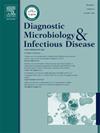Utility of anaerobic blood cultures in the clinical management of infectious patients
IF 2.1
4区 医学
Q3 INFECTIOUS DISEASES
Diagnostic microbiology and infectious disease
Pub Date : 2025-01-20
DOI:10.1016/j.diagmicrobio.2025.116702
引用次数: 0
Abstract
Paired aerobic/anaerobic cultures are routinely performed for the diagnosis of bacteraemia. This study aimed to assess the utility of anaerobic cultures in the management of infectious patients. All positive blood cultures taken from adult patients in a French hospital between November 2018 and March 2020 were evaluated. Clinical and microbiological data were collected for all patients with a positive anaerobic culture. Among the 17,272 positive pairs, 1402 included an anaerobic culture (8 %). In the 487 patients with anaerobic bacteraemia, the most commonly detected microorganisms were Enterobacterales (45 %), Staphylococcus aureus (16 %) and obligate anaerobes (6 %). In the 30 patients with obligate anaerobic bacteraemia, the most commonly detected bacterial species were Bacteroides spp. (30 %). When the bacteraemia-causing microorganism grew in both cultures (76 %), the anaerobic culture became positive prior to the aerobic culture in 54 % of cases—mainly for Enterobacterales and S. aureus. Our findings support the utility of performing anaerobic cultures.
求助全文
约1分钟内获得全文
求助全文
来源期刊
CiteScore
5.30
自引率
3.40%
发文量
149
审稿时长
56 days
期刊介绍:
Diagnostic Microbiology and Infectious Disease keeps you informed of the latest developments in clinical microbiology and the diagnosis and treatment of infectious diseases. Packed with rigorously peer-reviewed articles and studies in bacteriology, immunology, immunoserology, infectious diseases, mycology, parasitology, and virology, the journal examines new procedures, unusual cases, controversial issues, and important new literature. Diagnostic Microbiology and Infectious Disease distinguished independent editorial board, consisting of experts from many medical specialties, ensures you extensive and authoritative coverage.

 求助内容:
求助内容: 应助结果提醒方式:
应助结果提醒方式:


